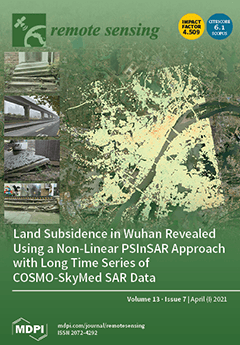As a widely used ground-based optical instrument, the LAI-2000 or LAI-2200 plant canopy analyzer (PCA) (Li-Cor, Inc., Lincoln, NE) is designed to measure the plant effective leaf area index (
Le) by measuring the canopy gap fraction at several limited or
[...] Read more.
As a widely used ground-based optical instrument, the LAI-2000 or LAI-2200 plant canopy analyzer (PCA) (Li-Cor, Inc., Lincoln, NE) is designed to measure the plant effective leaf area index (
Le) by measuring the canopy gap fraction at several limited or discrete view zenith angles (VZAs) (usually five VZAs: 7, 23, 38, 53, and 68°) based on Miller’s equation. Miller’s equation requires the probability of radiative transmission through the canopy to be measured over the hemisphere, i.e., VZAs in the range from 0 to 90°. However, the PCA view angle ranges are confined to several limited ranges or discrete sectors. The magnitude of the error produced by the discretization of VZAs in the leaf area index measurements remains difficult to determine. In this study, a theoretical deduction was first presented to definitely prove why the limited or discrete VZAs or ranges can affect the
Le measured with the PCA, and the specific error caused by the limited or discrete VZAs was described quantitatively. The results show that: (1) the weight coefficient of the last PCA ring is the main cause of the error; (2) the error is closely related to the leaf inclination angles (IAs)—the
Le measured with the PCA can be significantly overestimated for canopies with planophile IAs, whereas it can be underestimated for erectophile IAs; and (3) the error can be enhanced with the increment of the discrete degree of PCA rings or VZAs, such as using four or three PCA rings. Two corrections for the error are presented and validated in three crop canopies. Interestingly, although the leaf IA type cannot influence the
Le calculated by Miller’s equation in the hemispheric space, it affects the
Le measured with the PCA using the discrete form of Miller’s equation for several discrete VZAs.
Full article





